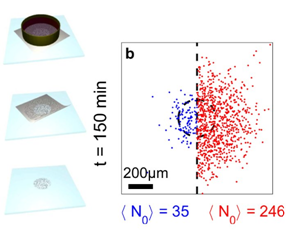
Quand leurs contacts facilitent le déplacement des cellules
Joseph D’Alessandro, Christophe Anjard, Jean-Paul Rieu et Charlotte Rivière (équipe Biophysique), en collaboration avec François Detcheverry (équipe Liquides et Interfaces) et des collègues de Sendai et de Boston, ont publié un article intitulé "Contact enhancement of locomotion in spreading cell colonies" dans la revue Nature Physics. Cet article a fait l'objet d'une actualité de l'INP du CNRS.

When cell-to-cell contacts make their movement more efficient
Joseph D’Alessandro, Christophe Anjard, Jean-Paul Rieu and Charlotte Rivière (team Biophysique), in collaboration with François Detcheverry (team Liquids and interfaces) and colleagues from Sendai and Boston, published an article entitled "Contact enhancement of locomotion in spreading cell colonies" in the journal Nature Physics. This article was highlighted in the news of the Physics Institute of CNRS.
On sait depuis un demi-siècle que les contacts entre cellules peuvent inhiber leur migration. En étudiant l’étalement d’une colonie de cellules peu cohésives (l’amibe Dictyostelium Discoideum), les auteurs viennent de montrer que les contacts peuvent au contraire accélérer leurs déplacements. Dans un travail associant expériences et simulations, ils ont montrés que les contacts transitoires entre cellules augmentent durablement leur vitesse et l’efficacité de leur déplacement (leur persistance), ce qui, à l’échelle de la population, accélère la dispersion de la colonie. Ces travaux représentent une avancée fondamentale pour la compréhension de la motilité cellulaire et soulèvent aussi de nouvelles questions en matière active.
It has been known for half a century that contacts between cells can inhibit their migration. By studying the spreading of colonies of non-cohesive cells (the amoeba Dictyostelium Discoideum), the authors have shown that contacts can instead accelerate their movements. In a work combining experiments and simulations, they showed that the transient contacts between cells durably increase their speed and their displacement efficiency (their persistence), which, at the level of the population, accelerates the dispersion of the colony. This work represents a fundamental advance for the understanding of cellular motility and also raises new questions in active matter.
27/10/2017




















